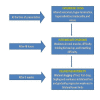The Enigma of Delayed Neurotoxicity in Organophosphate Poisoning: A Case Report of Clinical Presentation With Normal MRI Findings
- PMID: 39040753
- PMCID: PMC11262748
- DOI: 10.7759/cureus.62877
The Enigma of Delayed Neurotoxicity in Organophosphate Poisoning: A Case Report of Clinical Presentation With Normal MRI Findings
Abstract
Organophosphates (OP) are the most widely used pesticides globally and are misused for suicides because of their easy availability. It leads to functional impairment of distal segments of sensory and motor axons of peripheral nerves, as well as impacting the ascending and descending spinal tracts. It progresses through latent, progressive, static, and improvement phases. In the improvement phase, peripheral nerve regeneration occurs, revealing the spinal cord lesion with myelopathic features. The acute symptoms and treatments of OP poisoning have been extensively documented in the literature. Delayed neurotoxicity is a rare but debilitating condition that can manifest weeks after initial exposure. A high index of suspicion for OP-induced delayed neurotoxicity should be maintained in patients presenting with delayed neurological symptoms post-OP exposure, even with normal MRI findings. OP linked to delayed neuropathy include triorthocresyl phosphate, chlorpyriphos, malathion, fipronil, mipafox, matriphonate, and parathion. Among these, the most hazardous OP ester is tri-o-cresyl phosphate. We report a case of a 28-year-old male who developed neurotoxicity five weeks following OP poisoning with chlorpyrifos. Early diagnosis and symptomatic management are important for improving patient outcomes.
Keywords: intermediate syndrome; myelopathy; organophosphate induced delayed neurotoxicity; organophosphate induced polyneuropathy; organophosphate pesticide poisoning.
Copyright © 2024, Chhabra et al.
Conflict of interest statement
Human subjects: Consent was obtained or waived by all participants in this study. Conflicts of interest: In compliance with the ICMJE uniform disclosure form, all authors declare the following: Payment/services info: All authors have declared that no financial support was received from any organization for the submitted work. Financial relationships: All authors have declared that they have no financial relationships at present or within the previous three years with any organizations that might have an interest in the submitted work. Other relationships: All authors have declared that there are no other relationships or activities that could appear to have influenced the submitted work.
Figures




Similar articles
-
Delayed myelopathy after organophosphate intoxication: A case report.SAGE Open Med Case Rep. 2022 Jun 16;10:2050313X221104309. doi: 10.1177/2050313X221104309. eCollection 2022. SAGE Open Med Case Rep. 2022. PMID: 35747241 Free PMC article.
-
Chlorpyrifos-induced delayed myelopathy and pure motor neuropathy: a case report.Neurologist. 2012 Jul;18(4):226-8. doi: 10.1097/NRL.0b013e318261035b. Neurologist. 2012. PMID: 22735254
-
Organophosphorus poisoning induced delayed neurotoxicity: a report of two cases.Spinal Cord Ser Cases. 2023 Nov 4;9(1):54. doi: 10.1038/s41394-023-00611-4. Spinal Cord Ser Cases. 2023. PMID: 37925431 Free PMC article.
-
Organophosphate-induced delayed polyneuropathy.Toxicol Rev. 2005;24(1):37-49. doi: 10.2165/00139709-200524010-00003. Toxicol Rev. 2005. PMID: 16042503 Review.
-
Organophosphate induced delayed polyneuropathy in man: an overview.Clin Neurol Neurosurg. 2011 Jan;113(1):7-10. doi: 10.1016/j.clineuro.2010.08.015. Epub 2010 Sep 28. Clin Neurol Neurosurg. 2011. PMID: 20880629 Review.
References
-
- Neurotoxic effects of organophosphorus insecticides. An intermediate syndrome. Senanayake N, Karalliedde L. N Engl J Med. 1987;316:761–763. - PubMed
-
- Chlorpyrifos-induced delayed myelopathy and pure motor neuropathy: a case report. Thivakaran T, Gamage R, Gunarathne KS, Gooneratne IK. Neurologist. 2012;18:226–228. - PubMed
Publication types
LinkOut - more resources
Full Text Sources
Miscellaneous

